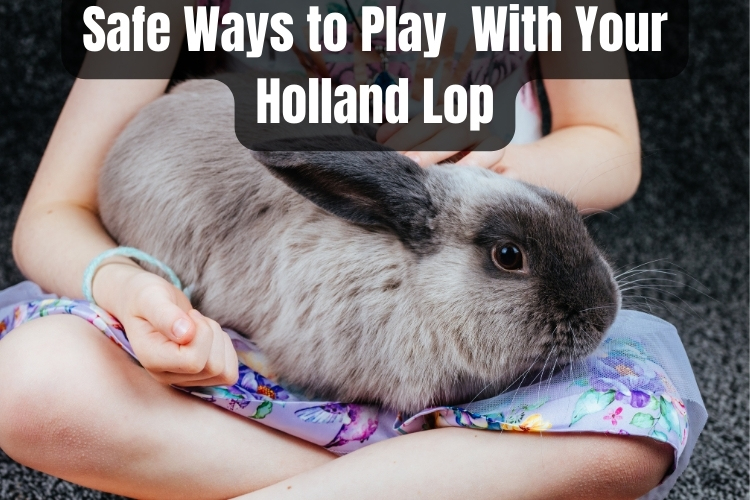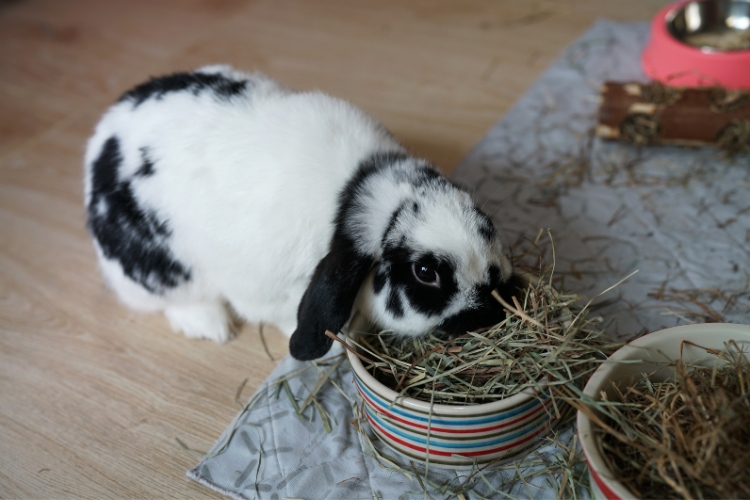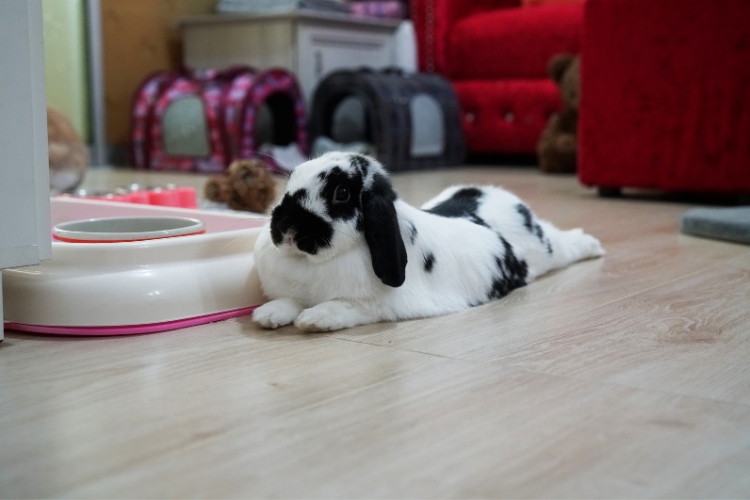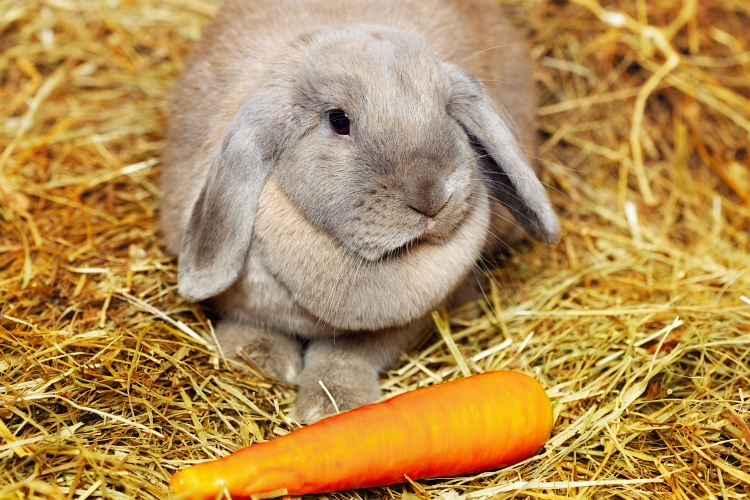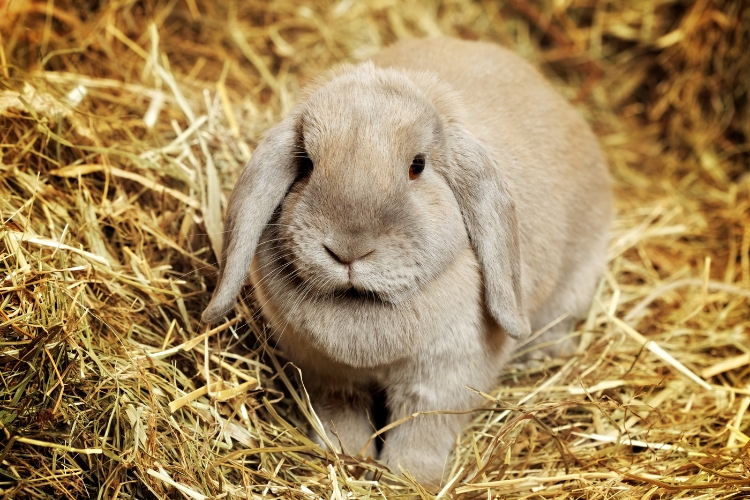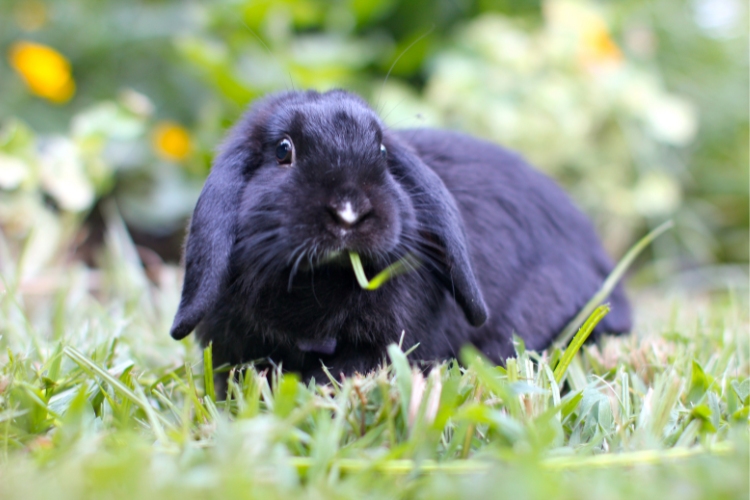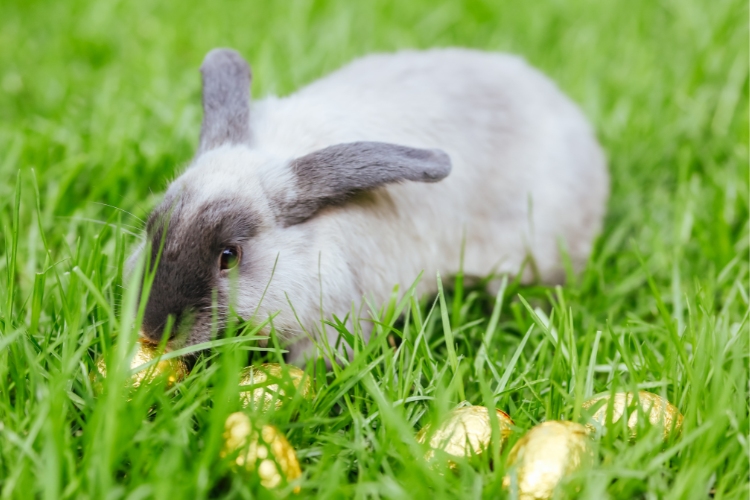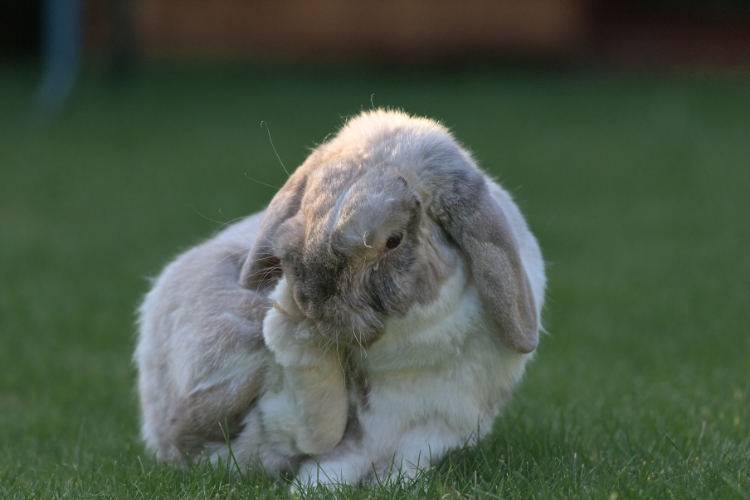Holland Lops are adorable and lively companions that require a safe and engaging environment to thrive. Whether you’re a seasoned rabbit owner or considering adopting one, it’s important to understand the specific needs of a Holland Lop to ensure their well-being.
In this blog post guide, we will explore safe ways to play and interact with your Holland Lop, touching upon their living space, social needs, diet, exercise, and bonding techniques. Here are some key takeaways to keep in mind when caring for these charming bunnies.
Key Takeaways
- Customize your Holland Lop’s cage with a spacious 4’x2′ setup, ensuring stability with modifications like zip ties and easy litterbox access for a comfortable living environment.
- Engage in regular, gentle interaction with your Holland Lop, recognizing their affection through content behaviors and balancing their need for attention with independence.
- Provide a balanced diet with controlled treat portions to prevent overindulgence, and offer safe vegetables like kale and bok choy in moderation to avoid digestive issues.
- Create a secure play area for exercise and introduce supervised outdoor playtime, ensuring any space is bunny-proofed to prevent accidents and encourage healthy binkies.
- Learn proper handling techniques, avoiding stressful methods like scruffing, and understand your Holland Lop’s body language to strengthen your bond and ensure their comfort.
Creating a Comfortable and Safe Living Space
Customizing Your Holland Lop’s Cage
Creating a personalized living space for your Holland Lop is essential for their well-being. A spacious cage, ideally a 4’x2′ wire grid setup, allows for ample room to move, play, and rest. Ensure the door is large enough for your bunny to easily access the litterbox and for you to reach in for cleaning and interaction.
Stability is key in a rabbit’s habitat. Use zip ties or similar fasteners to secure the cage components, preventing any wobbly or unsafe structures. Remember, a stable home is a safe home for your furry friend.
Consider the following list when customizing your Holland Lop’s cage:
- Adequate size for free movement
- Easy access to food and water
- A comfortable sleeping area
- Room for toys and enrichment activities
By tailoring the cage to your Holland Lop’s needs, you provide a foundation for a happy and healthy life. Take inspiration from other Holland Lop owners who have built custom cages, ensuring their bunnies have a space that is both functional and comforting.
The Importance of Proper Litterbox Access
Ensuring your Holland Lop has proper litterbox access is crucial for their well-being and hygiene. Rabbits have a natural instinct to use a specific spot for their waste, which can be harnessed to maintain a clean and odor-free living space.
By placing the litterbox in the area your rabbit naturally selects for its bathroom needs, you encourage this instinctive behavior.
Here are some simple steps to enhance litterbox stability and ensure your bunny’s comfort:
- Choose a litterbox that is large enough for your Holland Lop to move around in comfortably.
- Place the litterbox in a corner of the cage that your rabbit seems to prefer for its bathroom habits.
- Secure the litterbox to the cage to prevent tipping or moving, using safe fasteners or weights.
- Regularly clean the litterbox to prevent unpleasant odors and maintain sanitation.
Remember, a well-maintained litterbox promotes a healthy environment for your rabbit and simplifies cleaning routines for you.
Enhancing Stability with Simple Modifications
To ensure your Holland Lop feels secure and comfortable, consider enhancing the stability of their living space with simple modifications. Adding non-slip mats or tiles can provide a solid footing, preventing slips and falls. This is particularly important for rabbits, as they are prone to injuries from unstable surfaces.
When customizing your bunny’s habitat, it’s essential to maintain a balance between enrichment and safety. For example, you might introduce low platforms or ramps for exploration, but ensure they are sturdy and have a gentle incline to avoid any risk of tipping over. Here’s a quick checklist to help you enhance stability:
- Use heavy-bottomed bowls to prevent tipping during mealtime.
- Secure any loose wires or accessories that could cause entanglement.
- Opt for a well-constructed hideout that won’t collapse easily.
Remember, a stable environment not only promotes physical well-being but also contributes to your rabbit’s emotional health. By referencing resources like ‘Raising Rabbits: A Month-by-Month Guide – Kavee‘, you can further tailor your pet’s environment to their developmental stages and unique needs.
Understanding Your Holland Lop’s Social Needs
The Benefits of Regular Interaction
Regular interaction with your Holland Lop is crucial for their emotional well-being. Engaging with your bunny for up to 4 hours daily can significantly reduce the risk of depression and promote a healthy, active lifestyle.
It’s not just about the quantity of time spent, but also the quality of your interactions. Establishing a routine that includes play, grooming, and simply being present can lead to a deeper bond between you and your pet.
Holland Lops are intelligent creatures that thrive on social engagement. They can become as affectionate and interactive as any dog or cat when given the chance. To ensure your rabbit gets the most out of these interactions, consider the following points:
- Provide a variety of toys to keep them mentally stimulated.
- Include grooming in your bonding time to enhance trust.
- Observe your rabbit’s behavior to understand their preferences for interaction.
Remember, while regular attention is beneficial, it’s also important to respect your rabbit’s need for independence. Allowing them some alone time is essential for their overall happiness.
Recognizing Signs of Affection and Contentment
Understanding the behavior of your Holland Lop can greatly enhance the bond you share. One of the most obvious signs that your bunny is happy is its engagement in playful and active behavior.
Happy rabbits often exhibit a unique joyous action known as a ‘binky’, where they hop in the air, twist, and then land back on the ground. This, along with a constant wiggle of their nose, indicates a content state.
Rabbits also show affection in more subtle ways. They may circle your feet, gently groom you, or flop down close to you to express their trust and comfort.
When petted in their favorite spots, such as the cheeks or forehead, they may purr, signaling their enjoyment and relaxation. It’s important to recognize these behaviors as they reflect the emotional health of your Holland Lop.
Here are some signs that your rabbit likes you:
- Circling your feet
- Chinning
- Grooming you
- Flopping down close to you
- Performing binkies
- Sitting on your lap
- Approaching you for pets
- Purring when petted
By being attentive to these actions, you can ensure that your interactions with your Holland Lop are both rewarding and nurturing.
Balancing Attention and Independence
While Holland Lops are social creatures that thrive on interaction, it’s crucial to strike a balance between providing attention and respecting their independence. Rabbits are subject to depression and poor health if not given daily interaction and mental stimulation.
However, they also need time to themselves to explore and rest. Allowing your Holland Lop to initiate contact can prevent them from feeling overwhelmed. Sit on the floor and let them come to you, offering treats and gentle pets as they approach.
To ensure your Holland Lop’s well-being, aim for up to 4 hours of supervised time outside their cage each day. This not only fosters a strong bond but also caters to their intellectual and physical needs. Remember, patience and positive reinforcement are key when interacting with your bunny. They can be trained to use a litter box, come when called, and even perform tricks, enhancing the quality of the time you spend together.
Here are some tips to balance attention and independence for your Holland Lop:
- Observe your rabbit’s behavior to understand when they seek attention or prefer solitude.
- Create a routine that includes playtime, training, and quiet time.
- Use treats sparingly to encourage interaction without causing overdependence.
Nutrition and Treat Management
Healthy Diet Essentials for Holland Lops
A balanced diet is crucial for the health and well-being of your Holland Lop. Adult rabbits need a balanced diet of unlimited hay, fresh greens, and a few pellets.
This combination ensures that they receive the necessary fiber, vitamins, and minerals. Hay should be the staple of their diet, with timothy, orchard, or oat hay being excellent choices.
When it comes to fresh greens, variety is key. Introduce a mix of vegetables such as romaine lettuce, kale, parsley, and dandelion greens. However, it’s important to manage the portions to avoid digestive issues. Carrots, while often associated with rabbits, should be given sparingly due to their high sugar content.
Ensure that any commercial pellet diet is of high quality and free from fillers or artificial additives. Pellets should be given in moderation as part of a balanced diet, not as the main component. Always provide your Holland Lop with fresh water daily, using a clean water bottle or bowl.
Managing Treat Portions to Prevent Overindulgence
Holland Lops, like many pets, can easily develop a taste for certain treats and may overindulge if given the chance. Moderation is key when it comes to treat distribution to ensure your bunny maintains a healthy weight and digestive system.
Treats should complement, not replace, the essentials of their diet—hay and pellets. To prevent overindulgence, consider these guidelines:
- Offer treats in small quantities and not as a substitute for their main diet.
- Use treats as a reward for good behavior or as part of a training routine.
- Monitor your rabbit’s response to different treats, as some may cause digestive upset.
Remember, your Holland Lop’s diet should primarily consist of grass hay, with a measured amount of pellets and fresh veggies. Treats are just that—treats—and should be given sparingly to avoid health issues such as obesity or GI stasis.
Safe Vegetables and Foods for Your Bunny
Providing your Holland Lop with a balanced diet is crucial for their health and well-being. A diet rich in hay and fresh vegetables is essential for maintaining a healthy digestive system. Orchard grass hay, oat hay, and meadow hay are excellent choices that should make up the bulk of their diet.
When it comes to vegetables, variety is key. Introduce a mix of leafy greens such as kale, parsley, dandelion greens, and romaine lettuce to your bunny’s daily routine. However, it’s important to manage portions carefully, especially with vegetables like carrots and bok choy, which can easily lead to overindulgence.
Here’s a simple guide to safe vegetables and portion control for your Holland Lop:
- Kale: Rich in nutrients, but should be given in moderation to prevent digestive issues.
- Parsley: A good source of vitamins, but high in calcium, so it should be fed sparingly.
- Dandelion Greens: Excellent for foraging, but ensure they are free from pesticides.
- Romaine Lettuce: A hydrating choice, avoid iceberg lettuce as it contains little nutritional value.
Always remember to introduce new foods gradually and monitor your rabbit’s reaction to prevent any adverse effects.
Exercise and Playtime Essentials
Designing a Secure Play Area
Creating a secure play area for your Holland Lop is crucial for their well-being and exercise needs. Adequate space is essential, as rabbits require room to hop, play, and explore. A good rule of thumb is to provide at least 8 square feet of space per rabbit, ensuring they have freedom of movement within a safe environment.
When setting up the play area, the flooring should be made of a solid material to prevent injury to the rabbit’s delicate feet. It’s also important to include a variety of elements such as a nest box, food, water, and a litter box to mimic the rabbit’s natural habitat and provide comfort.
Here are some additional tips to ensure a safe play area:
- Bunny-proof the space by removing any hazardous objects and covering electrical cords.
- Ensure the playpen or enclosure has no sharp edges or dangerous items.
- The enclosure should have a securely lockable door to protect against predators.
Remember, while a secure play area is important, Holland Lops also need supervised exercise outside of their enclosure to meet their daily activity requirements.
Supervised Outdoor Activities and Binky Time
Providing your Holland Lop with supervised outdoor activities is crucial for their physical and mental well-being. Ensure their safety by creating a secure play area that is free from predators, toxic plants, and harmful substances.
Regular playtime not only allows them to exercise but also to exhibit natural behaviors such as the joyful ‘binky’ jump, indicating happiness and contentment. When planning outdoor time, consider the following:
- Always supervise your Holland Lop to prevent escape or injury.
- Bunny-proof the area to protect your pet and your belongings.
- Gradually increase outdoor time to allow your bunny to acclimate.
Remember, Holland Lops require approximately 4-5 hours of playtime daily. This can be split between indoor and outdoor environments, depending on weather and safety. By observing your bunny’s preferences, you can provide a variety of enrichment activities that cater to their unique personality.
Interactive Toys and Enrichment for Mental Stimulation
To keep your Holland Lop mentally stimulated and physically active, incorporating a variety of interactive toys is essential. Chew toys, tunnels, and puzzle feeders are not just fun; they cater to your bunny’s natural instincts to explore and forage. A well-chosen assortment of toys can significantly enhance your rabbit’s quality of life.
When selecting toys, consider the individual preferences of your Holland Lop. Some bunnies may favor certain types of toys over others. For instance, a rabbit that enjoys digging might appreciate a digging box, while another might spend hours maneuvering a puzzle feeder to retrieve treats. It’s important to observe and learn what your bunny loves to do.
Here are some recommended types of toys for your Holland Lop:
- Chew toys for dental health
- Tunnels for exploration
- Puzzle feeders for mental engagement
- Hideaways for comfort and security
Remember, safety is paramount. Always supervise your Holland Lop during playtime to prevent any accidents and ensure the toys are free of harmful substances.
Handling and Bonding Techniques
Proper Ways to Pick Up and Hold Your Holland Lop
Handling your Holland Lop correctly is crucial for its safety and your mutual trust. Always support your bunny’s hindquarters when lifting to prevent injury. Use one hand to gently scoop under the chest, and place the other hand beneath the rump.
This method ensures that the rabbit feels secure and is less likely to struggle or become frightened. When holding your Holland Lop, keep it close to your body to provide additional support and comfort.
It’s important to be calm and move slowly to avoid startling your pet. If your rabbit needs to be held for a longer period, consider sitting down and allowing it to rest in your lap.
Here are some key points to remember when picking up your Holland Lop:
- Approach your rabbit calmly and speak softly to avoid causing stress.
- Ensure your hands are clean and free of any strong scents that might be off-putting to your bunny.
- Never lift a rabbit by the ears or scruff, as this can cause pain and injury.
- Practice makes perfect. Regular, gentle handling will help your Holland Lop become accustomed to being picked up and held.
Why You Should Avoid Scruffing and Flipping
Handling your Holland Lop with care is crucial for their well-being. Scruffing, or holding a rabbit by the scruff of the neck, can be a deeply traumatic experience. It mimics the action of a predator, causing stress and fear.
Similarly, flipping a rabbit onto its back, known as ‘trancing,’ can lead to a state of paralysis and vulnerability, which is often mistaken for relaxation.
When interacting with your Holland Lop, it’s important to respect their preferences and comfort zones. Here are some areas to avoid:
- The scruff of the neck
- The belly
- The feet
- The rear end
Instead, focus on safe handling techniques that promote trust and security. Gentle strokes along the back and under the chin, where some rabbits enjoy being touched, can foster a positive bond. Always be mindful of your rabbit’s body language to ensure they are comfortable with the interaction.
Understanding Your Rabbit’s Body Language and Comfort Levels
Rabbits communicate much about their comfort and emotions through body language. Understanding these cues is crucial for a harmonious relationship with your Holland Lop.
For instance, a relaxed rabbit may lie down with legs stretched out, indicating they feel safe and content in your presence. Conversely, if your rabbit is hiding or reluctant to interact, it may signal stress or fear.
When interacting with your Holland Lop, pay attention to their favorite petting spots. Rabbits typically enjoy being stroked on the cheeks, forehead, shoulders, and back. These preferences stem from their natural grooming behaviors and can be a sign of trust when they allow you to touch these areas.
Here’s a simple list to help you recognize signs of affection:
- Circling your feet
- Chinning
- Grooming you
- Flopping down close to you
- Binkies
- Sitting on your lap
- Coming over for pets
- Purring when petted
Always approach your rabbit in a calm and gentle manner. Avoid scruffing or holding them by the neck, as this can be extremely traumatic. Instead, focus on building trust through consistent and positive interactions, respecting their need for independence, and being mindful of their individual personalities.
Conclusion
In conclusion, caring for a Holland Lop rabbit involves more than just providing a well-built cage and a nutritious diet. It’s about understanding their unique needs and behaviors to foster a loving and safe environment.
From ensuring they have ample space for exercise to avoiding stressful handling techniques like scruffing, every interaction should prioritize their well-being. Remember to supervise their playtime, be mindful of their dietary limits, and invest in toys that cater to their individual preferences.
By following these guidelines, you can build a bond with your Holland Lop that is both joyful and respectful, ensuring a happy and healthy companion for years to come.
FAQs:
How can I customize my Holland Lop’s cage for safety and comfort?
Customize your Holland Lop’s cage by ensuring it’s spacious enough, typically at least 4’x2′. Use wire grids for the structure and a large door for easy litterbox access. Enhance stability with zip ties or similar modifications to prevent any wobbling.
What are the signs that my Holland Lop is happy and content?
A happy Holland Lop may exhibit behaviors such as loafing on the couch with you, performing binkies during playtime, and showing a calm demeanor when interacting with family members.
What kind of diet is best for my Holland Lop?
A healthy diet for a Holland Lop includes hay, a moderate amount of pellets, fresh vegetables like kale and bok choy, and limited treats. Monitor treat portions to prevent overindulgence and stomach upset.
How can I safely exercise my Holland Lop?
Provide supervised exercise opportunities in a secure, bunny-proofed room or outdoor area. Ensure the space is free from hazards and predators, and never leave your Holland Lop unattended during playtime.
Is it safe to pick up and hold my Holland Lop frequently?
While Holland Lops can be held, it’s important to do so properly by supporting their bottom and back. Avoid over-handling as it can be stressful for them. Instead, allow them to play freely on the ground as much as possible.
Are there any handling techniques I should avoid with my Holland Lop?
Avoid scruffing (holding by the neck) and flipping your Holland Lop onto its back as these can be traumatic and stressful. Instead, learn to recognize your rabbit’s body language and handle them with care and respect for their comfort levels.

